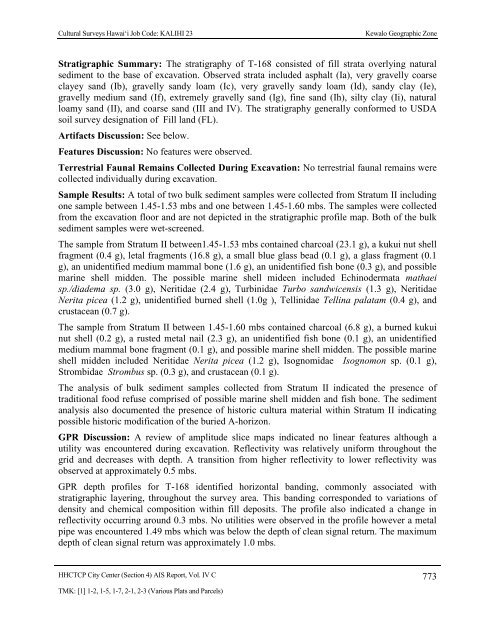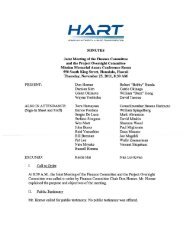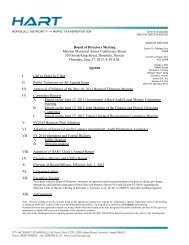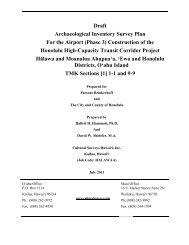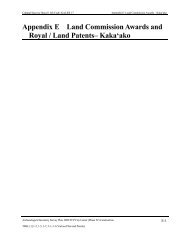4.12 Test Excavation 167 (T-167) - Honolulu Rail Transit Project
4.12 Test Excavation 167 (T-167) - Honolulu Rail Transit Project
4.12 Test Excavation 167 (T-167) - Honolulu Rail Transit Project
You also want an ePaper? Increase the reach of your titles
YUMPU automatically turns print PDFs into web optimized ePapers that Google loves.
Cultural Surveys Hawai‘i Job Code: KALIHI 23Kewalo Geographic ZoneStratigraphic Summary: The stratigraphy of T-168 consisted of fill strata overlying naturalsediment to the base of excavation. Observed strata included asphalt (Ia), very gravelly coarseclayey sand (Ib), gravelly sandy loam (Ic), very gravelly sandy loam (Id), sandy clay (Ie),gravelly medium sand (If), extremely gravelly sand (Ig), fine sand (Ih), silty clay (Ii), naturalloamy sand (II), and coarse sand (III and IV). The stratigraphy generally conformed to USDAsoil survey designation of Fill land (FL).Artifacts Discussion: See below.Features Discussion: No features were observed.Terrestrial Faunal Remains Collected During <strong>Excavation</strong>: No terrestrial faunal remains werecollected individually during excavation.Sample Results: A total of two bulk sediment samples were collected from Stratum II includingone sample between 1.45-1.53 mbs and one between 1.45-1.60 mbs. The samples were collectedfrom the excavation floor and are not depicted in the stratigraphic profile map. Both of the bulksediment samples were wet-screened.The sample from Stratum II between1.45-1.53 mbs contained charcoal (23.1 g), a kukui nut shellfragment (0.4 g), letal fragments (16.8 g), a small blue glass bead (0.1 g), a glass fragment (0.1g), an unidentified medium mammal bone (1.6 g), an unidentified fish bone (0.3 g), and possiblemarine shell midden. The possible marine shell mideen included Echinodermata mathaeisp./diadema sp. (3.0 g), Neritidae (2.4 g), Turbinidae Turbo sandwicensis (1.3 g), NeritidaeNerita picea (1.2 g), unidentified burned shell (1.0g ), Tellinidae Tellina palatam (0.4 g), andcrustacean (0.7 g).The sample from Stratum II between 1.45-1.60 mbs contained charcoal (6.8 g), a burned kukuinut shell (0.2 g), a rusted metal nail (2.3 g), an unidentified fish bone (0.1 g), an unidentifiedmedium mammal bone fragment (0.1 g), and possible marine shell midden. The possible marineshell midden included Neritidae Nerita picea (1.2 g), Isognomidae Isognomon sp. (0.1 g),Strombidae Strombus sp. (0.3 g), and crustacean (0.1 g).The analysis of bulk sediment samples collected from Stratum II indicated the presence oftraditional food refuse comprised of possible marine shell midden and fish bone. The sedimentanalysis also documented the presence of historic cultura material within Stratum II indicatingpossible historic modification of the buried A-horizon.GPR Discussion: A review of amplitude slice maps indicated no linear features although autility was encountered during excavation. Reflectivity was relatively uniform throughout thegrid and decreases with depth. A transition from higher reflectivity to lower reflectivity wasobserved at approximately 0.5 mbs.GPR depth profiles for T-168 identified horizontal banding, commonly associated withstratigraphic layering, throughout the survey area. This banding corresponded to variations ofdensity and chemical composition within fill deposits. The profile also indicated a change inreflectivity occurring around 0.3 mbs. No utilities were observed in the profile however a metalpipe was encountered 1.49 mbs which was below the depth of clean signal return. The maximumdepth of clean signal return was approximately 1.0 mbs.HHCTCP City Center (Section 4) AIS Report, Vol. IV C 773TMK: [1] 1-2, 1-5, 1-7, 2-1, 2-3 (Various Plats and Parcels)


